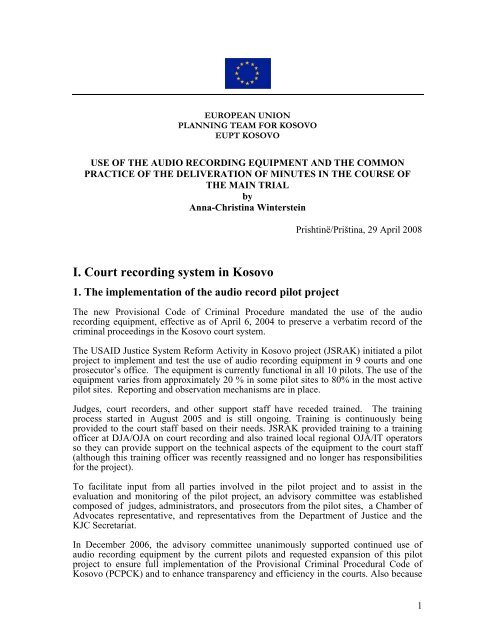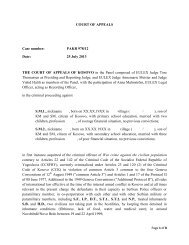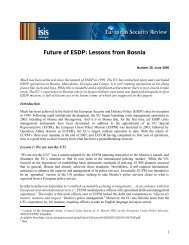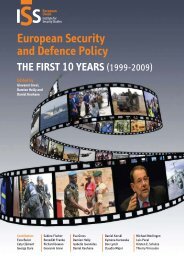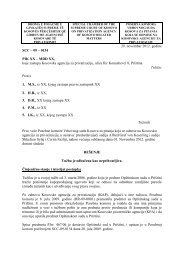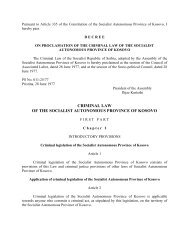I. Court recording system in Kosovo - Eulex
I. Court recording system in Kosovo - Eulex
I. Court recording system in Kosovo - Eulex
Create successful ePaper yourself
Turn your PDF publications into a flip-book with our unique Google optimized e-Paper software.
EUROPEAN UNION<br />
PLANNING TEAM FOR KOSOVO<br />
EUPT KOSOVO<br />
USE OF THE AUDIO RECORDING EQUIPMENT AND THE COMMON<br />
PRACTICE OF THE DELIVERATION OF MINUTES IN THE COURSE OF<br />
THE MAIN TRIAL<br />
by<br />
Anna-Christ<strong>in</strong>a W<strong>in</strong>terste<strong>in</strong><br />
Prisht<strong>in</strong>ë/Prišt<strong>in</strong>a, 29 April 2008<br />
I. <strong>Court</strong> <strong>record<strong>in</strong>g</strong> <strong>system</strong> <strong>in</strong> <strong>Kosovo</strong><br />
1. The implementation of the audio record pilot project<br />
The new Provisional Code of Crim<strong>in</strong>al Procedure mandated the use of the audio<br />
<strong>record<strong>in</strong>g</strong> equipment, effective as of April 6, 2004 to preserve a verbatim record of the<br />
crim<strong>in</strong>al proceed<strong>in</strong>gs <strong>in</strong> the <strong>Kosovo</strong> court <strong>system</strong>.<br />
The USAID Justice System Reform Activity <strong>in</strong> <strong>Kosovo</strong> project (JSRAK) <strong>in</strong>itiated a pilot<br />
project to implement and test the use of audio <strong>record<strong>in</strong>g</strong> equipment <strong>in</strong> 9 courts and one<br />
prosecutor’s office. The equipment is currently functional <strong>in</strong> all 10 pilots. The use of the<br />
equipment varies from approximately 20 % <strong>in</strong> some pilot sites to 80% <strong>in</strong> the most active<br />
pilot sites. Report<strong>in</strong>g and observation mechanisms are <strong>in</strong> place.<br />
Judges, court recorders, and other support staff have receded tra<strong>in</strong>ed. The tra<strong>in</strong><strong>in</strong>g<br />
process started <strong>in</strong> August 2005 and is still ongo<strong>in</strong>g. Tra<strong>in</strong><strong>in</strong>g is cont<strong>in</strong>uously be<strong>in</strong>g<br />
provided to the court staff based on their needs. JSRAK provided tra<strong>in</strong><strong>in</strong>g to a tra<strong>in</strong><strong>in</strong>g<br />
officer at DJA/OJA on court <strong>record<strong>in</strong>g</strong> and also tra<strong>in</strong>ed local regional OJA/IT operators<br />
so they can provide support on the technical aspects of the equipment to the court staff<br />
(although this tra<strong>in</strong><strong>in</strong>g officer was recently reassigned and no longer has responsibilities<br />
for the project).<br />
To facilitate <strong>in</strong>put from all parties <strong>in</strong>volved <strong>in</strong> the pilot project and to assist <strong>in</strong> the<br />
evaluation and monitor<strong>in</strong>g of the pilot project, an advisory committee was established<br />
composed of judges, adm<strong>in</strong>istrators, and prosecutors from the pilot sites, a Chamber of<br />
Advocates representative, and representatives from the Department of Justice and the<br />
KJC Secretariat.<br />
In December 2006, the advisory committee unanimously supported cont<strong>in</strong>ued use of<br />
audio <strong>record<strong>in</strong>g</strong> equipment by the current pilots and requested expansion of this pilot<br />
project to ensure full implementation of the Provisional Crim<strong>in</strong>al Procedural Code of<br />
<strong>Kosovo</strong> (PCPCK) and to enhance transparency and efficiency <strong>in</strong> the courts. Also because<br />
1
USAID’s JSRAK project ends on 30 June 2007, it was concluded that jo<strong>in</strong>t OJA/JSRAK<br />
responsibility for the function<strong>in</strong>g of the current pilot sites must be replaced by exclusive<br />
KJC Secretariat responsibility.<br />
Therefore <strong>in</strong> a meet<strong>in</strong>g on March 2007 KJC decide that the Secretariat, under direction of<br />
the <strong>Court</strong> Adm<strong>in</strong>istration Committee will develop practical options for fund<strong>in</strong>g of the<br />
enlargement of the audio <strong>record<strong>in</strong>g</strong> project Secretariat and will identify the possibility the<br />
f<strong>in</strong>ancial support for this project. An additional other duty of the Secretariat is to develop<br />
logistic plans for tra<strong>in</strong><strong>in</strong>g.<br />
Currently the <strong>Court</strong> Adm<strong>in</strong>istration Committee together with the Secretariat and JSRAK<br />
are work<strong>in</strong>g on draft<strong>in</strong>g the procedures for us<strong>in</strong>g the audio <strong>record<strong>in</strong>g</strong> equipment <strong>in</strong> future<br />
by all courts.<br />
2. Advantages of Audio Record<strong>in</strong>g:<br />
One obvious reason for the requirement <strong>in</strong> the Provisional Crim<strong>in</strong>al Procedural Code of<br />
<strong>Kosovo</strong> Code for the requirement for audio <strong>record<strong>in</strong>g</strong> of crim<strong>in</strong>al case proceed<strong>in</strong>gs is to<br />
<strong>in</strong>crease the transparency. Audio <strong>record<strong>in</strong>g</strong> provides a complete record of everyth<strong>in</strong>g<br />
said dur<strong>in</strong>g a hear<strong>in</strong>g. If there is any question at a later time, for example, <strong>in</strong> appeal,<br />
whether specific evidence was presented, the audio record will be available for<br />
<strong>in</strong>spection. That precise record also would allow a review of precisely what was said<br />
dur<strong>in</strong>g a hear<strong>in</strong>g, if a question is later raised regard<strong>in</strong>g the professional behavior of a<br />
judge, prosecutor, or lawyer.<br />
In addition, the use of audio <strong>record<strong>in</strong>g</strong> <strong>in</strong>troduces the opportunity to <strong>in</strong>crease efficiency <strong>in</strong><br />
a number of ways:<br />
• The existence of the audio record could elim<strong>in</strong>ate the necessity of preparation of<br />
m<strong>in</strong>utes, or a typewritten record for most proceed<strong>in</strong>gs, sav<strong>in</strong>g staff time.<br />
• Because the staff person attend<strong>in</strong>g to the <strong>record<strong>in</strong>g</strong> equipment is not required to<br />
be mak<strong>in</strong>g detailed notes, that person may have time <strong>in</strong> the courtroom to perform<br />
other tasks to assist the judge dur<strong>in</strong>g the proceed<strong>in</strong>gs, such as complet<strong>in</strong>g required<br />
forms at the time of hear<strong>in</strong>g and ma<strong>in</strong>ta<strong>in</strong><strong>in</strong>g evidence presented dur<strong>in</strong>g hear<strong>in</strong>gs.<br />
• The current procedures for m<strong>in</strong>ute tak<strong>in</strong>g require that the judge recite the<br />
testimony and evidence presented by parties <strong>in</strong> a proceed<strong>in</strong>g <strong>in</strong> order to prepare<br />
the official record of the proceed<strong>in</strong>gs. With appropriate guidel<strong>in</strong>es, most of the<br />
time spent on this task can be elim<strong>in</strong>ated, s<strong>in</strong>ce parties and those <strong>in</strong>terested <strong>in</strong> the<br />
court record can use the audio <strong>record<strong>in</strong>g</strong> for review<strong>in</strong>g the record of a case. This<br />
approach would save considerable time spent now dur<strong>in</strong>g hear<strong>in</strong>gs ensur<strong>in</strong>g that<br />
the dictated record is accurate.<br />
3. <strong>Court</strong>s and Prosecution’s Office where a pilot project to implement<br />
and test the use of audio <strong>record<strong>in</strong>g</strong> equipment has been <strong>in</strong>itiated:<br />
1) District <strong>Court</strong> of Prist<strong>in</strong>a (courtroom and judge’s office)<br />
Due to lack of use the equipment from DC Prist<strong>in</strong>a has been transferred to DC <strong>in</strong><br />
Peja<br />
2) District prosecutor’s office <strong>in</strong> Prisht<strong>in</strong>a, (prosecutor’s office)<br />
2
3) Municipal <strong>Court</strong> <strong>in</strong> Prisht<strong>in</strong>a, (courtroom and judge’s office)<br />
4) District <strong>Court</strong> <strong>in</strong> Mitrovica, (courtroom)<br />
5) Municipal <strong>Court</strong> <strong>in</strong> Mitrovica, (courtroom)<br />
6) District <strong>Court</strong> <strong>in</strong> Prizren, (courtroom)<br />
7) District <strong>Court</strong> <strong>in</strong> Gjilan, (courtroom & judges offices)<br />
In all other <strong>Court</strong> the traditional <strong>system</strong> is still <strong>in</strong> place, which is a summary of notes<br />
typed by the <strong>Court</strong> Recorder dur<strong>in</strong>g the trial sessions.<br />
II. Common Practice of M<strong>in</strong>utes Delivery <strong>in</strong> <strong>Kosovo</strong><br />
The m<strong>in</strong>utes are delivered only upon request of the parties. Usually only the judge and<br />
the m<strong>in</strong>ute-taker sign the m<strong>in</strong>utes <strong>in</strong> the end of each session dur<strong>in</strong>g the ma<strong>in</strong> trial of a<br />
crim<strong>in</strong>al proceed<strong>in</strong>g. It is not very common that the parties request the m<strong>in</strong>utes of the<br />
ma<strong>in</strong> trial session <strong>in</strong> crim<strong>in</strong>al proceed<strong>in</strong>gs and <strong>in</strong> any case they are requested by the<br />
defense counsel not by the prosecutor.<br />
3


